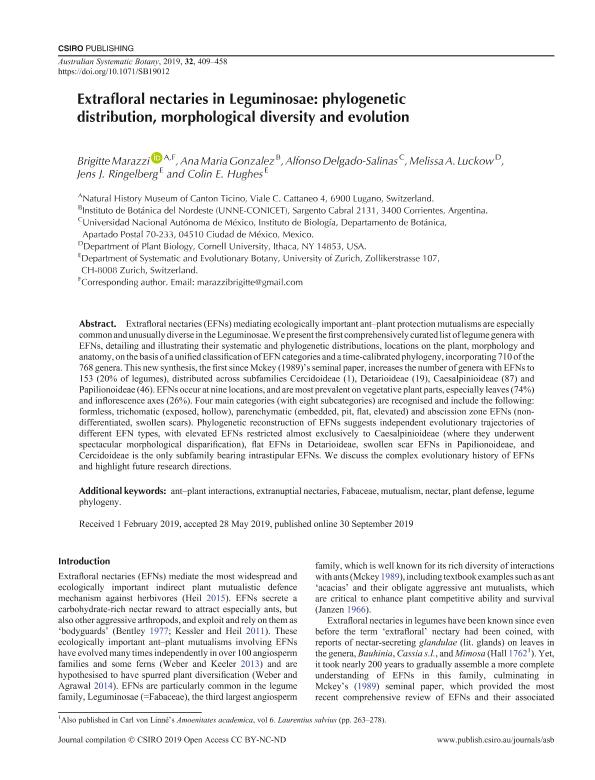Artículo
Extrafloral nectaries in Leguminosae: phylogenetic distribution, morphological diversity and evolution
Marazzi, Brigitte ; González, Ana María
; González, Ana María ; Delgado Salinas, Alfonso; Luckow, Melissa A.; Ringelberg, Jens J.; Hughes, Colin E.
; Delgado Salinas, Alfonso; Luckow, Melissa A.; Ringelberg, Jens J.; Hughes, Colin E.
 ; González, Ana María
; González, Ana María ; Delgado Salinas, Alfonso; Luckow, Melissa A.; Ringelberg, Jens J.; Hughes, Colin E.
; Delgado Salinas, Alfonso; Luckow, Melissa A.; Ringelberg, Jens J.; Hughes, Colin E.
Fecha de publicación:
09/2019
Editorial:
Csiro Publishing
Revista:
Australian Systematic Botany
ISSN:
1030-1887
Idioma:
Inglés
Tipo de recurso:
Artículo publicado
Clasificación temática:
Resumen
Extrafloral nectaries (EFNs) mediating ecologically important ant-plant protection mutualisms are especially common and unusually diverse in the Leguminosae. We present the first comprehensively curated list of legume genera with EFNs, detailing and illustrating their systematic and phylogenetic distributions, locations on the plant, morphology and anatomy, based on a unified classification of EFN categories and a time-calibrated phylogeny incorporating 710 of the 768 genera. This new synthesis, the first since McKey (1989)?s seminal paper, increases the number of genera with EFNs to 152 (20% of legumes), distributed across subfamilies Cercidoideae (1), Detarioideae (19), Caesalpinioideae (87) and Papilionoideae (45). EFNs occur at nine locations, and are most prevalent on vegetative plant parts, especially leaves (74%) and inflorescence axes (26%). Four main categories (with eight subcategories) are recognized: formless, trichomatic (exposed, hollow), parenchymatic (embedded, pit, flat, elevated) and abscission zone EFNs (non-differentiated, swollen scars). Phylogenetic reconstruction of EFNs suggests independent evolutionary trajectories of different EFN types, with elevated EFNs restricted almost exclusively to Caesalpinioideae (where they underwent spectacular morphological disparification), flat EFNs in Detarioideae, swollen scar EFNs in Papilionoideae, and Cercidoideae is the only subfamily bearing intrastipular EFNs. We discuss the complex evolutionary history of EFNs and highlight future research directions.
Palabras clave:
EXTRAFLORAL NECTARIES
,
LEGUMINOSAE
,
PAPILIONOIDEAE
,
CAESALPINIOIDEAE
Archivos asociados
Licencia
Identificadores
Colecciones
Articulos(IBONE)
Articulos de INST.DE BOTANICA DEL NORDESTE (I)
Articulos de INST.DE BOTANICA DEL NORDESTE (I)
Citación
Marazzi, Brigitte; González, Ana María; Delgado Salinas, Alfonso; Luckow, Melissa A.; Ringelberg, Jens J.; et al.; Extrafloral nectaries in Leguminosae: phylogenetic distribution, morphological diversity and evolution; Csiro Publishing; Australian Systematic Botany; 32; 9-2019; 409-458
Compartir
Altmétricas



